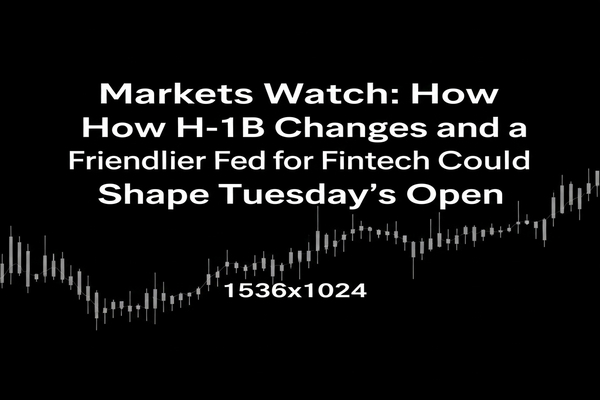
High-skilled immigration rules are costing U.S. growth. New analysis argues the H-1B lottery leaves productivity on the table while a big fee hike and potential policy fixes make the issue urgent for technology hiring now. At the same time, a Federal Reserve governor is signaling openness to fintech access to payment rails, and defense spending gains are lifting related ETFs. These forces could reshape sector flows in the near term and alter longer term earnings mix for tech, payments and defense globally.
Market preview for the coming session
U.S. markets head into the session digesting policy moves that affect three distinct corners of the market. Traders will weigh the potential squeeze on tech hiring from immigration rules and fee increases against easier access to payment infrastructure that could lift fintech valuations. Separately, rising defense budgets that pushed global defense spending to about $2.7 trillion in 2024 will keep interest alive in defense-related names and exchange traded products.
Expect the initial tone to favor sectors that benefit from sustained government spending and regulatory accommodation. However, short term volatility could appear in software and hardware names that rely heavily on imported engineers. The narrative today is not simply risk on or risk off. It is a rotation story. Investors will compare near term headwinds to long term productivity gains that could follow if immigration rules are retooled.
High-skilled immigration: an overlooked supply shock for tech
New research argues the H-1B lottery design wastes economic potential by allocating visas at random rather than prioritizing higher compensation and the highest value hires. That matters now because the administration has raised the effective application fee to roughly $100,000 for some filings. The fee change is intended to deter frivolous or bulk applications and tilt the system toward more valuable hires.
For markets, this creates two immediate consequences. First, labor costs and hiring timelines for certain enterprise software and advanced semiconductors could climb. Companies that previously relied on a steady flow of overseas engineers may face delays in filling roles, which can slow product road maps and extend timelines for revenue recognition. Second, the policy tradeoff could favor firms that have deeper domestic talent pipelines or that can pay premium wages to secure priority access.
Globally, the impact is uneven. U.S. firms could see higher operating costs and slightly lower near term productivity compared with peers in Europe and parts of Asia that have more flexible talent programs. Emerging markets that supply high-skilled applicants may face slower remittance flows if migration becomes more costly. Over the longer term, policy redesign that prices visas by compensation could raise the return on the H-1B program and support U.S. innovation, but changes will take time to filter into earnings and hiring statistics.
Fed openness to fintech could reprice payments and bank-adjacent stocks
Federal Reserve governor Christopher Waller said the central bank intends to engage with fintechs and to consider controlled access to master accounts through a new form of account with guardrails. The proposal would allow entrepreneurial firms to connect more directly to payment rails while limiting risks such as overdrafts and emergency lending exposure. The comments were delivered at a payments innovation conference yesterday and represent a notable shift from a historically cautious Fed posture.
Markets interpret this in a few ways. Payments processors and fintech platforms may see a future pathway to scale with lower reliance on incumbent bank partners. That could improve gross margins for successful platforms. Banks that currently monetize transaction flow by serving as intermediaries may face margin pressure in those lines of business, though many also benefit from a wider payments ecosystem.
Cryptocurrency related firms and decentralized finance projects will watch the specifics closely. Access to Fed rails without full bank charters would lower operational frictions for some startups. However, guardrails and caps mean the move is not an open invitation to unlimited access. The tone from the Fed is constructive. Still, the pace of regulatory implementation will determine how quickly markets respond.
Defense spending gains create a steady bid for sector ETFs
Global defense spending rose about 9.4 percent year on year to roughly $2.7 trillion in 2024. That shift supports demand for companies focused on advanced systems, cybersecurity and defense tech. Product sponsors are positioning vehicles to capture this demand. One example is Global X’s Defense Tech ETF, listed as NYSEARCA:SHLD on the exchange, which aims to concentrate exposure in defense related technologies while excluding commercial aviation.
For traders, defense exposure can act as a defensive growth play during periods of policy-driven reallocation. The sector tends to show relative resilience when governments prioritize modernization and supply chain security. Internationally, allies with rising defense budgets and procurement cycles may favor suppliers in the U.S. and allied markets, which supports an export tilt to revenue forecasts for selected contractors.
Scenarios for the session and what to watch
Early trading will likely respond to headlines about implementation details. If firms announce adjustments to hiring plans because of visa cost changes, tech shares with high R&D intensity could underperform. Conversely, detailed guidance from the Fed that clarifies access rules for fintechs could lift payments and software-as-a-service providers that target banking clients.
Key data points to watch include any follow up commentary from Treasury or the Fed on operational timelines and market reaction to specific corporate statements about hiring and capital allocation. Earnings calendars and macro prints will still matter. However, the cross currents from immigration policy, Fed messaging, and defense budgets create a multi-sector narrative that could drive intra-day rotation.
This session is likely to reward active reading of regulatory announcements and company responses. Traders and portfolio managers will need to separate temporary re-pricing from longer term shifts that could affect sector weightings over quarters. The immediate market impact will hinge on clarity and speed of implementation, not just the policy intent.
Disclosure: This report is informational only. It does not constitute investment advice or a recommendation to buy or sell any security.












